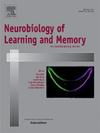海马成年神经元的记忆处理
IF 1.8
4区 心理学
Q3 BEHAVIORAL SCIENCES
引用次数: 0
摘要
本文综述了成人海马齿状回(DG)中神经发生的功能作用,特别关注其对整个生命周期记忆过程的影响。这篇综述的一个显著特点是它的系统方法,按照记忆的各个阶段,从最初的编码,到睡眠依赖性的巩固,再到检索,最后是遗忘,按时间顺序组织了成年神经元(abn)的贡献。尽管成人DG中神经发生的存在和程度仍有争议,但越来越多的证据表明,abn支持整个成年期的认知功能。当考虑到与衰老和阿尔茨海默病等神经系统疾病相关的认知能力下降时,这一观点尤为重要,这些疾病与成人神经发生的大幅减少有关。我们比较了传统的DG功能模型和新兴的证据,突出了abn的共同和独特贡献。例如,DG在模式分离中的作用是公认的,而作为这一功能的关键媒介,abns由于其瞬间增强的可塑性和兴奋性,似乎对区分新的或类似的经历至关重要。另一方面,最近的研究结果强调了abn在快速眼动睡眠期间记忆巩固中的独特和重要作用,表明在DG中发育出生的颗粒细胞中缺乏abn的特殊功能。在临床上,加强记忆相关疾病(包括创伤后应激障碍(PTSD))的神经发生的潜在治疗重要性被强调,强调了有前途的治疗方法,如美金刚。最后,我们概述了关键的未解决的问题,倡导未来的研究旨在了解abn特定的机制。海马abn绝不仅仅是进化的遗迹,它代表了神经可塑性的动态和基本要素,这对记忆的形成、适应和整个生命周期的恢复能力至关重要。本文章由计算机程序翻译,如有差异,请以英文原文为准。
Memory processing by hippocampal adult-born neurons
This review provides an integrative overview of the functional roles of adult neurogenesis in the hippocampal dentate gyrus (DG), focusing specifically on its impact on memory processes across the lifespan. A distinguishing feature of this review is its systematic approach, organizing the contributions of adult-born neurons (ABNs) chronologically through the stages of memory—from initial encoding, through sleep-dependent consolidation, retrieval, and finally forgetting.
Although the existence and extent of adult neurogenesis in the human DG remain debated, accumulating evidence suggests that ABNs support cognitive functions throughout adulthood. This perspective gains particular importance when considering cognitive decline associated with aging and neurological disorders such as Alzheimer’s disease, which are linked to substantial reductions in adult neurogenesis.
We compare traditional models of DG function with emerging evidence highlighting both shared and unique contributions of ABNs. For example, the DG is well-established for its role in pattern separation, and as key mediators of this function, ABNs—due to their transiently heightened plasticity and excitability—appear critical for discriminating novel or similar experiences. On the other hand, recent findings underscore the distinct and essential role of ABNs in memory consolidation during REM sleep, suggesting specialized functions of ABNs that are absent in developmentally born granule cells in the DG.
Clinically, the potential therapeutic importance of enhancing neurogenesis in memory-related disorders, including post-traumatic stress disorder (PTSD), is emphasized, highlighting promising treatments such as memantine. Lastly, we outline key unresolved questions, advocating for future research aimed at understanding ABN-specific mechanisms. Far from being a mere evolutionary vestige, hippocampal ABNs represent dynamic and essential elements of neural plasticity that are critical for memory formation, adaptation, and resilience across the lifespan.
求助全文
通过发布文献求助,成功后即可免费获取论文全文。
去求助
来源期刊
CiteScore
5.10
自引率
7.40%
发文量
77
审稿时长
12.6 weeks
期刊介绍:
Neurobiology of Learning and Memory publishes articles examining the neurobiological mechanisms underlying learning and memory at all levels of analysis ranging from molecular biology to synaptic and neural plasticity and behavior. We are especially interested in manuscripts that examine the neural circuits and molecular mechanisms underlying learning, memory and plasticity in both experimental animals and human subjects.

 求助内容:
求助内容: 应助结果提醒方式:
应助结果提醒方式:


